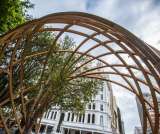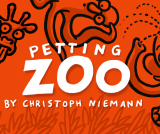
For those who don’t know, the annual Design Indaba is a world class conference centered around all things design orientated.
So, I didn’t post today.
And it always makes me quite anxious, like I’m frittering away precious ideas that will lose their glorious sheen once pressed onto the lined pages of a book and left to seep for some days.
I do have a good reason, though.
And that reason is the wondrous fact that I won a ticket to attend the Design Indaba Simulcast, via Elle Deco. In a way I feel bad, because it’s almost like I made them give it to me, with all my persistent tweeting and nudging… but… in a way… I totally deserve it! And I am making the most of it (follow my tweets for both The Pessimiss and my day job at Colourworks, and you’ll see just how much).
For those who don’t know, the annual Design Indaba is a world class conference centered around all things design orientated – from architecture, to social design, to graphic and multimedia design, to trend forecasting and industrial design. It’s basically three days crammed with speakers from all over the globe, speaking on things so inspiring they might drive you to tears- from sheer appreciation, awe or envy.
Today we listened to Francis Kere, an architect from Burkino Faso, talk about preserving culture and tradition in his hometown by building infrastructure their own way. Instead of building high rise structures popularised and suited to urban landscapes, Francis embraces the inclusive nature of his people and gets everyone from children to mothers to grandparents involved in smoothing in traditional clay floors. Francis was so animated he could scarcely confine himself to the stage allotted, and both audiences were so moved by his clear and emotive understanding of the people of his country, that people literally wanted to hug the man when he said his thanks.
Dror Benshetrit, an Israeli-born creative, unveiled a project he has spent four years working on today at the Design Indaba. Social media channels were alight with the news that he was ‘giving birth,’ and it was indeed a momentous and stirring occasion. QuaDror, the revolutionary support structure that he and his team have invented, is composed of four identical L-shaped pieces, that, when arranged in a certain, form a solid base for a vast array of structures. Dror explained that he was building on work done by the likes of Da Vinci andBuckminster Fuller, if that gives you an idea of the magnitude of the occasion.
Acclaimed UK design agency, Hat-Trick, were my favourite, rifling through a collection of 19 incredibly emotive pieces of work at a rate of knots and with tons of charm and laughs along the way. From typographic campaigns for the Sumatran Orangutang Society to self-published volumes that are there for no other reason than to exist as a memoir of one person’s life, Hat-Trick have spent time and energy on ideas. Great ideas.
And that’s what the Design Indaba is all about. Giving room, appreciation and light to great ideas. Whether they be about affecting social change, or getting people to do or see something, or just because.
Three trends that seemed to make their presence felt on day 1, and which I look forward to seeing develop in the next 2 days include:
1. Co-design - collaborating with other creatives and with direct users of products to create the best solutions possible.
2. Design that improves lives and living - from healthcare, to public transport, to banking.
3. Design for innovation’s sake - design for no other reason than to create something exquisite, hilarious or historic. As South African speaker Richard Hart termed it: ‘Utterly beautiful, but useless.’
These are trends that filter implicitly into fashion, too. We see brands incorporating elements of co-design into their businesses in many ways. Take, for example, the hauling trend that has taken America by storm. Corporations now approach girls in their specific target markets to do their hauls and to consult on what other girls want. Collaboration, too, has become an important mechanism for both economising and innovating in the fashion industry. Look at luxury brand collaborations with high street chain stores – Lanvin x H&M or Kate Moss for Topshop.
More and more, fashion is also developing a conscience. How do you feel about wearing fur or leather? Or have you considered the impact your spending habits have on your carbon footprint? What kind of packaging did your brand new shoes come in? Do you support brands that manufacture their clothing under harsh working conditions? These are things the fashion industry is also taking into consideration, design wise.
And of course, the final point. Art for art’s sake. I watched The Last Emperor, a movie about Valentino and his decadent, crumbling empire this week at the Design Indaba Film Fest, and it plays very much to this dichotomy: excess and fabulousness (or art for art’s sake) vs. modernity and commercialism. 90% of revenue at big fashion houses is generated through accessories, like handbags, belts and watches, not through the extravagant couture shows we all love to love. How can someone like Valentino, whose gowns are handstitched by a team of eagle-eyed artists, and to whom each gown is a triumph, conceive of licensing away his name and churning out hundreds of V-emblazoned clutch bags to the masses? Economy dictates these changes.
Perhaps more fashion people need to come and spend a day at Design Indaba. Perhaps we all need to relook the way we perceive design and its purpose, and see that it can be used to change lives, to educate and to stun.









